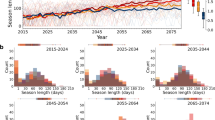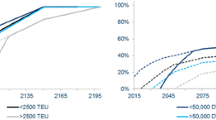Abstract
The economic potential of the Northern Sea Route (NSR) as a seasonal Arctic passage between Europe and Asia is controversial. Despite the retreating Arctic Sea ice cover, seasonal shipping along the NSR requires icebreaker support and the utilisation of ice-class ships. To support operational and fleet investment decisions, we analyse the supply dynamics of cargo shipping and icebreaker capacity in the event of growing cargo volumes along the NSR through a system dynamics model till year 2065. In the model, the initial tonnage is based on existing fleet, while hypothetical cargo growth assumes three levels (low, medium and high), and climatic conditions follow three alternative scenarios (melting, baseline and freezing). The model results indicate that over 30 million tonnes of cargo p.a. would be needed to maintain a sustainable level of traffic in the NSR, compared to less than 4 million tonnes in 2014. During the modelled 50-year-period, on average 24 to 44 per cent of potential NSR cargo volume will be lost due to ageing icebreakers and ice-classed fleets and the slow newbuilding pace. The findings suggest that NSR’s economic potential for global shipping is likely to remain marginal for decades to come because of its inherent constraints.

(source: Authors)







Similar content being viewed by others
References
ABS – American Bureau of Shipping (2014) Navigating the Northern Sea Route Status and Guidance. http://ww2.eagle.org/content/dam/eagle/publications/2014/NSR_Advisory.pdf, accessed 16 November 2015.
Arctic Council (2009) Arctic Marine Shipping Assessment 2009 Report. Tromsø, Norway: Arctic Council.
Beenstock, M. and Vergottis, A. (1989) An Econometric Model of the World Tanker Market. Journal of Transport Economics and Policy 23(3): 263–280.
Bekkers, E., Francois, J.F. and Rojas-Romagosa, H. (2015) Melting Ice Caps and the Economic Impact of Opening the Northern Sea Route. Hague, The Netherlands: CPB Netherlands Bureau for Economic Policy Analysis. CPB Discussion Paper 307.
Cariou, P. and Faury, O. (2015) Relevance of the Northern Sea Route (NSR) for bulk shipping. Transportation Research Part A 78: 337–346.
China Daily Europe (2015) China mulls routine navigation through Arctic to Europe. http://europe.chinadaily.com.cn/china/2015-10/26/content_22289246.htm, accessed 11 November 2015.
Coyle, R.G. (1978) Tanker chartering. A system dynamics case study. European Journal of Operational Research 2(2): 86–96.
CRSL – Clarkson Research Services Limited (2015) Clarksons World Fleet Register. http://wfr.clarksons.net/wfr/, accessed 5 January 2015.
Dikos, G., Marcus, H.S., Papadatos, M.P. and Papakonstantinou. V. (2006) Niver lines: A system dynamics approach to tanker freight modeling. Interfaces 36(4): 326–341.
Dinwoodie, J., Tuck, S. and Rigot-Müller, P. (2013) Maritime oil freight flows to 2050: Delphi perceptions of maritime specialists. Energy Policy 63: 553–561.
Doyle, A. (2013) China plans first commercial trip through Arctic shortcut in 2013. Reuters, Oslo. http://www.reuters.com/article/shipping-china-idUSL6N0C4F9720130312, accessed 21 June 2014.
Engelen, S., Meersman, H. and Van De Voorde, E. (2006) Using system dynamics in maritime economics: an endogenous decision model for shipowners in the dry bulk sector. Maritime Policy & Management 33(2): 144–158.
Erikstad, S.O. and Ehlers, S. (2012) Decision support framework for exploiting Northern Sea Route transport opportunities. Ship Technology Research 59(2): 34–42.
Forrester, J.W. (1961) Industrial Dynamics. Cambridge, MA: MIT Press.
Furuichi, M. and Otsuka N. (2014) Economic feasibility of finished vehicle and container transport by NSR/SCR-combined shipping between East Asia and Northwest Europe, 15–18 July, Norfolk, USA, Presentation at the International Association of Maritime Economist (IAME) Conference.
Furuichi, M. and Otsuka, N. (2015) Proposing a common platform of shipping cost analysis of the Northern Sea Route and the Suez Canal Route. Maritime Economics & Logistics 17: 9–31.
Gautier, D.L., Bird, K.J., Charpentier, R.R., Grantz, A., Houseknecht, D.W., Klett, T.R., Moore, T.E., Pitman, J.K., Schenk, C.J., Schuenemeyer, J.H., Sørensen, K., Tennyson, M.E., Valin, Z.C. and Wandrey, C.J. (2009) Assessment of undiscovered oil and gas in the Arctic. Science 324(5931): 1175–1179.
Granberg, A.G. (1998) The northern sea route: Trends and prospects of commercial use. Ocean & Coastal Management 41(2–3): 175–207.
Gritsenko, D. and Kiiski, T. (2016) A review of Russian ice-breaking tariff policy on the northern sea route 1991–2014. Polar Record 52(2): 144–158.
Harsem, Ø., Eide, A. and Heen, K. (2011) Factors influencing future oil and gas prospects in the Arctic. Energy Policy 39(12): 8037–8045.
Hoffmann, J. and Kumar, S. (2010) Globalization: the Maritime Nexus. In: C.T. Grammenos (ed.) The Handbook of Maritime Economics and Business. 2nd edn. London: Informa, Lloyds List Press, pp. 35–64.
Humpert, M. (2015) Frozen waters: Northern Sea Route traffic boosted by internal traffic, while transits fall sharply. High North News December 15, 2015. http://www.highnorthnews.com/frozen-waters-northern-sea-route-traffic-boosted-by-internal-traffic-while-transits-fall-sharply/, accessed 21 December 2015.
IMO – International Maritime Organisation (2016) International Code for Ships Operating in Polar Waters (Polar Code). London: International Maritime Organisation.
Jin, Y. (2010) Investment in container ships for the Yangtze River: A System Dynamics Model. In: A.V. Brito (ed) Dynamic Modelling. Vukovar, HR: InTech, pp. 111–124.
Khon, V. C., Mokhov, I.I., Latif, M., Semenov, V.A. and Park, W. (2010) Perspectives of Northern Sea Route and Northwest Passage in the twenty-first century. Climatic Change 100(3): 757–768.
Koskinen, M.-M. and Hilmola, O.-P. (2005) Investment Cycles in the newbuilding market of ice-strengthened oil tankers. Maritime Economics & Logistics 7: 173–188.
Lasserre F. and Pelletier, S. (2011) Polar super seaways? Maritime transport in the Arctic: An analysis of ship-owners intentions. Journal of Transport Geography 19(6): 1465–1473.
Lasserre, F. (2014) Case studies of shipping along the Arctic routes. Analysis and profitability perspectives for container sector. Transportation Research Part A 66: 144–161.
Lee, T. and Kim, H. J. (2015) Barriers of voyaging on the Northern Sea Route: A perspective from shipping companies. Marine Policy 62: 264–270.
Lei, R., Xie, H. Wang, J. Leppäranta, M. Jónsdóttir, I. and Zhang, Z. (2015) Changes in sea ice conditions along the Northeast Passage from 1979 to 2012. Cold Regions Science and Technology 119: 132–144.
Liu, M. and Kronbak. J. (2010) The potential economic viability of using the Northern Sea Route (NSR) as an alternative route between Asia and Europe. Journal of Transport Geography 18(3): 434–444.
Lloyd’s Register, Qinetiq and Strathclyde University (2013) Global Marine Trends 2030. London.
Marken, V.B., Ehlers, S. and Khan F. (2015) Delay risk analysis of ship sailing the northern sea route. Ship Technology Research 62(1): 26–35.
Moe, A. (2014) The Northern Sea Route: Smooth sailing ahead? Strategic Analysis 38(6): 784–802.
Mulherin, N.D. (1996) The Northern Sea Route. Its development and Evolving State of Operations in the 1990s. Us Army Corps of Engineers, Cold Regions Research & Engineering Laboratory. CRREL Report 96-3.
Ng, T.-S. and Lam, S.-W. (2011) Dynamic maritime systems inquiry: The DIVER approach. Systems Engineering 14(3): 239–254.
NSRIO – Northern Sea Route Information Office (2016) Transit statistics. http://www.arctic-lio.com/nsr_transits, accessed 19 April 2016.
OAO Novatek (2015) Yamal LNG infrastructure. http://www.novatek.ru/en/business/yamal-lng/yamal_infrastructure/, accessed 8 November 2015.
Omer, M., Mostashari, A., Nilchiani, R. and Mansouri. M. (2012) A framework for assessing resiliency of maritime transportation systems. Maritime Policy and Management 39(7): 685–703.
Overland, J. and Wang, M. (2013) When will the summer Arctic be nearly sea ice free? Geophysical Research Letters 40(10): 2097–2101.
Paris, C. and Chiu, J. (2015) Chinese Shipping Group Cosco Planning Regular Trans-Arctic Sailings. The Wall Street Journal, October 29. http://www.wsj.com/articles/chinese-shipper-cosco-to-schedule-regular-trans-arctic-sailings-1446133485, accessed 11 November 2015.
Park, S.I., Wang, Y., Yeo, G.T. and Ng, A.K.Y. (2014) System dynamics modeling for determining optimal ship sizes and types in coastal liner services. The Asian Journal of Shipping and Logistics 30(1): 31–50.
Petrunin, V.V., Fadeev, Y.P., Panov, V.A., Pakhomov, A.N., Polunichev, V.I. and Golubeva. D.A. (2013) Service life extension and safety enhancement of ship reactors. Atomic Energy 113(6): 410–414.
Pettersen, T. (2012) Russia scraps three nuclear icebreakers. Barents Observer January 26, 2012. http://barentsobserver.com/en/nuclear-safety/russia-scraps-three-nuclear-icebreakers.
Ragner, C.L. (2000) Northern Sea Route cargo flows and infrastructure – present state and future potential. Lysaker, Norway: Fridtjof Nansen Institute. FNI report 13
Rahmstorf, S., Box, J.E., Feulner, G., Mann, M.E., Robinson, A., Rutherford, S. and Schaffernicht, E.J. (2015) Exceptional twentieth-century slowdown in Atlantic Ocean overturning circulation. Nature Climate Change 5: 475–480.
Randers, J. and Göluke, U. (2007) Forecasting turning points in shipping freight rates: lessons from 30 years of practical effort. System Dynamics Review 23(2–3): 253–284.
Raza, Z. and Schøyen. H. (2014) The commercial potential for LNG shipping between Europe and Asia via the Northern Sea Route. Journal of Maritime Research 11(2): 67–79.
Rosatom (2014) Rosatom annual report 2013. http://www.ar2013.rosatom.ru/254.html, accessed 3 November 2015.
Røseth, T. (2014) Russia’s China Policy in the Arctic. Strategic Analysis 38 (6): 841–859.
Schøyen, H. and Bråthen. S. (2011) The Northern Sea Route versus the Suez Canal: Cases from bulk shipping. Journal of Transport Geography 19(4): 977–983.
Staalesen, A. (2014) Yard delays delivery of icebreaker. Barents Observer November 21, 2014. http://barentsobserver.com/en/arctic/2014/11/yard-delays-delivery-icebreaker-21-11, accessed 19 November 2015.
Stephenson, S.R., Brigham, L.W. and Smith, L.C. (2014) Marine accessibility along Russia’s Northern Sea Route. Polar Geography 37(2): 111–133.
Stopford, M. (2009) Maritime Economics. 3rd edn. London: Routledge.
Stroeve J.C, Serreze, M.C., Holland, M.M., Kay, J.E., Maslanik, J. and Barrett, A.P. (2012) The Arctic’s rapidly shrinking sea ice cover: A research synthesis. Climate Change 110(3): 1005–1027.
Suez Canal Authority (2015) Suez Canal Traffic Statistics. http://www.suezcanal.gov.eg/TRstat.aspx?reportId=1, accessed 11 November 2015.
Tavasszy, L., Minderhoud, M., Perrin, J.-F. and Notteboom. T. (2011) A strategic network choice model for global container flows: Specification, estimation and application. Journal of Transport Geography 19: 1163–1172.
Taylor, A.J. (1976) System dynamics in shipping. Operational Research Quarterly 27(1): 41–56.
UNCTAD – United Nations Conference on Trade and Development (2015) Review of Maritime Transport 2015. New York: United Nations Publications.
Verny, J. – Grigentin, C. (2009) Container shipping on the Northern Sea Route. International Journal of Production Economics 122: 107–117.
Østreng, W., Eger, K.M., Fløistad, B., Jørgensen-Dahl, A., Lothe, L., Mejlænder-Larsen, M. and Wergeland, T. (2013) Shipping in Arctic Waters. A Comparison of the Northeast, Northwest and Trans Polar Passages. Chichester, UK: Springer–Praxis.
Author information
Authors and Affiliations
Corresponding author
Appendices
Appendix 1
Appendix 2
Appendix 3
Rights and permissions
About this article
Cite this article
Kiiski, T., Solakivi, T., Töyli, J. et al. Long-term dynamics of shipping and icebreaker capacity along the Northern Sea Route. Marit Econ Logist 20, 375–399 (2018). https://doi.org/10.1057/s41278-016-0049-1
Published:
Issue Date:
DOI: https://doi.org/10.1057/s41278-016-0049-1







